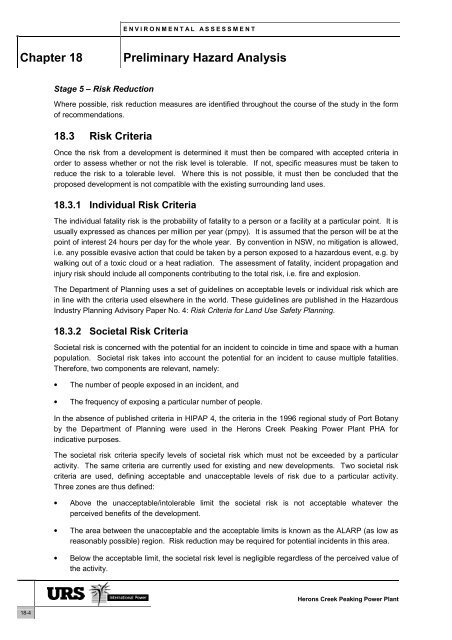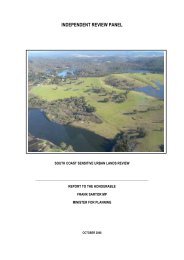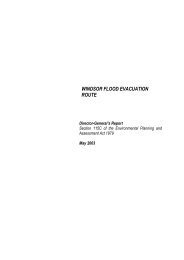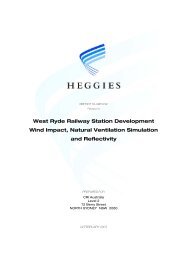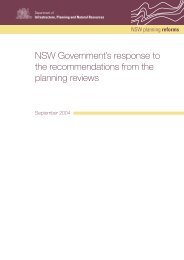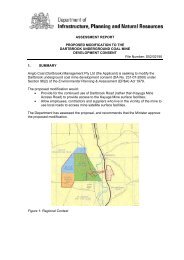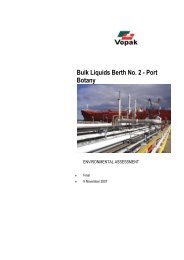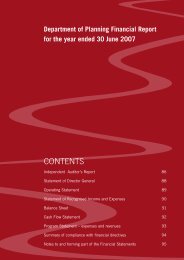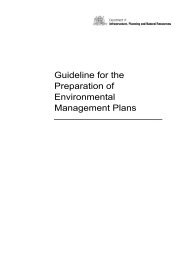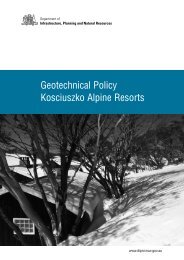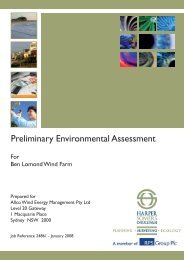Preliminary Hazard Analysis - Department of Planning
Preliminary Hazard Analysis - Department of Planning
Preliminary Hazard Analysis - Department of Planning
You also want an ePaper? Increase the reach of your titles
YUMPU automatically turns print PDFs into web optimized ePapers that Google loves.
E N V I R O N M E N T A L A S S E S S M E N T<br />
Chapter 18<br />
<strong>Preliminary</strong> <strong>Hazard</strong> <strong>Analysis</strong><br />
Stage 5 – Risk Reduction<br />
Where possible, risk reduction measures are identified throughout the course <strong>of</strong> the study in the form<br />
<strong>of</strong> recommendations.<br />
18.3 Risk Criteria<br />
Once the risk from a development is determined it must then be compared with accepted criteria in<br />
order to assess whether or not the risk level is tolerable. If not, specific measures must be taken to<br />
reduce the risk to a tolerable level. Where this is not possible, it must then be concluded that the<br />
proposed development is not compatible with the existing surrounding land uses.<br />
18.3.1 Individual Risk Criteria<br />
The individual fatality risk is the probability <strong>of</strong> fatality to a person or a facility at a particular point. It is<br />
usually expressed as chances per million per year (pmpy). It is assumed that the person will be at the<br />
point <strong>of</strong> interest 24 hours per day for the whole year. By convention in NSW, no mitigation is allowed,<br />
i.e. any possible evasive action that could be taken by a person exposed to a hazardous event, e.g. by<br />
walking out <strong>of</strong> a toxic cloud or a heat radiation. The assessment <strong>of</strong> fatality, incident propagation and<br />
injury risk should include all components contributing to the total risk, i.e. fire and explosion.<br />
The <strong>Department</strong> <strong>of</strong> <strong>Planning</strong> uses a set <strong>of</strong> guidelines on acceptable levels or individual risk which are<br />
in line with the criteria used elsewhere in the world. These guidelines are published in the <strong>Hazard</strong>ous<br />
Industry <strong>Planning</strong> Advisory Paper No. 4: Risk Criteria for Land Use Safety <strong>Planning</strong>.<br />
18.3.2 Societal Risk Criteria<br />
Societal risk is concerned with the potential for an incident to coincide in time and space with a human<br />
population. Societal risk takes into account the potential for an incident to cause multiple fatalities.<br />
Therefore, two components are relevant, namely:<br />
• The number <strong>of</strong> people exposed in an incident, and<br />
• The frequency <strong>of</strong> exposing a particular number <strong>of</strong> people.<br />
In the absence <strong>of</strong> published criteria in HIPAP 4, the criteria in the 1996 regional study <strong>of</strong> Port Botany<br />
by the <strong>Department</strong> <strong>of</strong> <strong>Planning</strong> were used in the Herons Creek Peaking Power Plant PHA for<br />
indicative purposes.<br />
The societal risk criteria specify levels <strong>of</strong> societal risk which must not be exceeded by a particular<br />
activity. The same criteria are currently used for existing and new developments. Two societal risk<br />
criteria are used, defining acceptable and unacceptable levels <strong>of</strong> risk due to a particular activity.<br />
Three zones are thus defined:<br />
• Above the unacceptable/intolerable limit the societal risk is not acceptable whatever the<br />
perceived benefits <strong>of</strong> the development.<br />
• The area between the unacceptable and the acceptable limits is known as the ALARP (as low as<br />
reasonably possible) region. Risk reduction may be required for potential incidents in this area.<br />
• Below the acceptable limit, the societal risk level is negligible regardless <strong>of</strong> the perceived value <strong>of</strong><br />
the activity.<br />
Herons Creek Peaking Power Plant<br />
18-4


